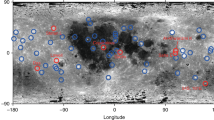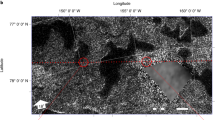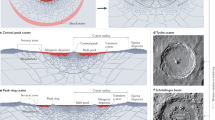Abstract
THE Goose Lake meteorite was sitting on the surface of the Earth when found1 and had no apparent crater associated with its impact. The absence of a crater undoubtedly means that the vertical component of velocity at the time of impact was extremely small. While a parabolic or hyperbolic orbit with grazing incidence is a theoretical possibility, the probability of such a meteoroid trajectory is relatively low. Furthermore, no impact scars are found1 on the meteorite, as might be expected if it had struck the Earth's surface with an appreciable horizontal component of velocity. Krinov2 indicates that those Sikhote–Alin fragments that had a mass about equal to the mass of the Goose Lake meteorite produced impact craters approximately 10 m in diameter. The Sikhote–Alin meteoroid entered the Earth's atmosphere with a velocity of 14.5 km/sec, a relatively low velocity for incoming meteoroids.
This is a preview of subscription content, access via your institution
Access options
Subscribe to this journal
Receive 51 print issues and online access
$199.00 per year
only $3.90 per issue
Buy this article
- Purchase on Springer Link
- Instant access to full article PDF
Prices may be subject to local taxes which are calculated during checkout
Similar content being viewed by others
References
Butler, C. P., Proc. Calif. Acad. Sci., 32, 291 (1963).
Krinov, E. L., in The Moon, Meteorites and Comets, edit. by Middlehurst, B. M., and Kuiper, G. P., 208 (Univ. Chicago Press, 1963).
Butler, C. P. (submitted to Meteoritics)
Cook, C. S., Nature, 204, 867 (1964).
Shoemaker, E. M., in The Moon, Meteorites and Comets, edit. by Middlehurst, B. M., and Kuiper, G. P., 301 (Univ. Chicago Press, 1963).
American Institute of Physics Handbook, second ed., 2 (McGraw-Hill Book Company, Inc., 1963).
Macklin, W. C., and Ludlam, F. H., Quart. J. Roy. Meteor. Soc., 87, 72 (1961).
Author information
Authors and Affiliations
Rights and permissions
About this article
Cite this article
COOK, C., BUTLER, C. Origin of the Goose Lake Meteorite. Nature 206, 704–705 (1965). https://doi.org/10.1038/206704a0
Published:
Issue Date:
DOI: https://doi.org/10.1038/206704a0
Comments
By submitting a comment you agree to abide by our Terms and Community Guidelines. If you find something abusive or that does not comply with our terms or guidelines please flag it as inappropriate.



